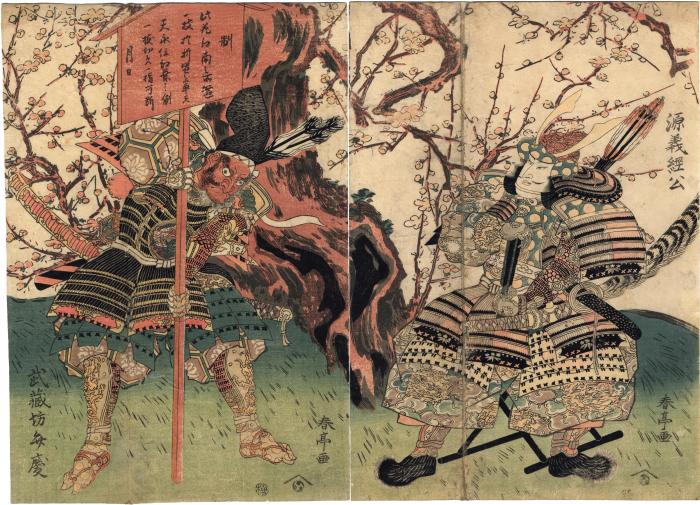Katsukawa Shuntei (勝川春亭) (artist 1770 – 1820)
Yoshitsune (源義經公) and Benkei (武蔵坊弁慶) and the signboard warning to Kumagai
ca 1795
20 in x 14.25 in (Overall dimensions) Japanese woodblock print
Signed: Shuntei ga (春亭画)
Publisher: Nishimuraya Yohachi
(Marks 391 seal 01-008)
Censor's seal: kiwame
Museum of Fine Arts, Boston - Hokkei surimono of Benkei planting the signboard
Náprstek Museum In Heroes of the Kabuki Stage by Arendie and Henk Herwig wrote on page 204 that Yoritomo was worried that Kumagai would do battle with Atsumori, a descendant of the emperor. Yoshitune wanted to warn Kumagai and had Benkei set this signboard up just outside of his camp. Written on the board is this passage: "isshi wo kitaba, isshi wo kiru beshi". It was placed in the ground in front of a blossoming cherry tree. "This sentence had a double meaning. Literally, it mens 'Anyone cutting a branch from this tree must have a finger cut off'; it could also be interpreted as 'If you kill sombody [sic] else's son, you must kill your own son'. Kumagai saw the notice board and understood both meanings at once. Quietly he made up his mind."
****
On the right Yoshitsune is seated in full armor. A very subtle motif is to be found in several places on this elaborate protective suit, the sasarindō (笹竜胆), a personal Minamoto clan crest.
Mark Griffiths wrote about the sasarindō on page 245 in his The Lotus Quest: In Search of the Sacred Flower: "The personal, rather than clan mon of Minamoto no Yoritomo was the sasarindō, a design in which three flowers of rindō (the Japanese gentian, Gentiana scabra or G. makinoi) sit above three leaves of the shrubby bamboo Sasa. The gentian was characteristic of the damp grassland flora of Southern Japan, while the bamboo was a signature plant of the North. This elegant posy is iconographic code for the shogun: the North is subjugated by the South; the country united under his military authority."
****
"In this legendary scene, Benkei, the famous warrior-monk of the late twelfth century, plants a signboard in front of a gnarled plum tree at Daimotsu Bay by order of his master, Minamoto no Yoshitsune. Based on an edict issued in the Ten'ei period (1110-1112) for a famous maple tree, the sign reads... 'If you break off one branch of this tree, one of your fingers will be cut off.' The date on the sign, Ju'ei 3 (1184), marks the beginning of the Gempei wars, and the year Yoshitsune and the Minamoto troops defeated the Taira at the decisive battle of Ichinotani."
Quoted from: Jewels of Japanese Printmaking: Surimono of the Bunka-Bunsei Era 1804-1830, by Joan B. Mirviss, p. 98.
****
Henri Joly wrote on page 413 of Legend in Japanese Art : A Description of Historical Episodes, Legendary Characters, Folk-lore Myths, Religious Symbolism Illustrated in the Arts of Old Japan:
"[Yoshitsune] is also depicted ordering Benkei to write the following notice on a plum tree at Amagasaki (sometimes attributed to Daimotsu in Settsu): -
"Even in Kuan (Chinese province famous for its plum trees) could not be found such a tree; according to the example set up for a maple tree in the period of Ten-ei, if a robber breaks a twig of it he shall forfeit one of his fingers as a penalty": -
Isshi wo Kirubesshi.
"Yoshitsune's notice contains a pun on branch and finger (both isshi)."
****
Illustrated
1) in color in Catalogue of Japanese Art in the Náprstek Museum published by The International Research Center for Japanese Studies: Nichibunken Japanese Studies Series 4, 1994, p. 29.
2) in color in Heroes of the Kabuki Stage by Arendie and Henk Herwig, Hotei Publishing, 2004, p. 204, no. 18.2. This is the same one linked to above at the Náprstek Museum, Prague.
Nishimuraya Yohachi (西村屋与八) (publisher)
warrior prints (musha-e - 武者絵) (genre)
Musashibō Benkei (武蔵坊弁慶) (role)
Minamoto no Yoshitsune (源義経) (role)
